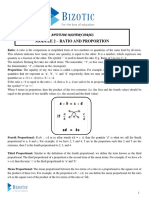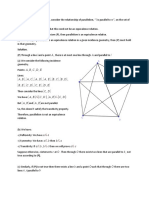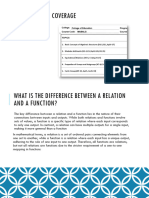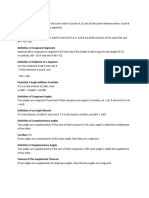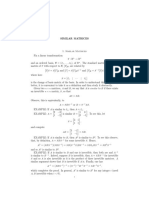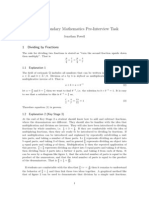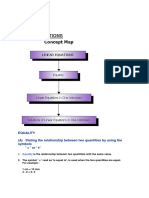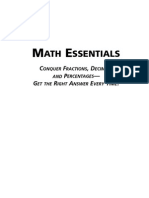Proportion Notes
Proportion Notes
Uploaded by
Norliza SapatanohCopyright:
Available Formats
Proportion Notes
Proportion Notes
Uploaded by
Norliza SapatanohOriginal Title
Copyright
Available Formats
Share this document
Did you find this document useful?
Is this content inappropriate?
Copyright:
Available Formats
Proportion Notes
Proportion Notes
Uploaded by
Norliza SapatanohCopyright:
Available Formats
Proportion
Proportion
If a "is proportional" to b (which is the same as 'a is in direct proportion with b') then as b
increases, a increases. In fact, there is a constant number k with a = kb. We write a b if a is
proportional to b.
The value of k will be the same for all values of a and b and so it can be found b substitutin!
in values for a and b.
Example
If a b, and b = "# when a = $, find an e%uation connectin! a and b.
a = kb (")
&ubstitute the values of $ and "# into the e%uation to find k'
$ = "#k
so k = "()
substitute this into (")
a = *b
In this e+ample we mi!ht then be asked to find the value of a when b = ). ,ow that we have a
formula connectin! a and b (a = * b) we can subsitute b=) to !et a = ".
&imilarl, if m is proportional to n), then m = kn) for some constant number k.
If + and are in direct proportion then the !raph of a!ainst + will be a strai!ht line.
Inverse Proportion (HIGHER TIER)
If a and b are inversel proportionall to one another,
a "(b
therefore a = k(b
In these e+amples, k is known as the constant of variation.
Example
If b is inversel proportional to the s%uare of a, and when a = -, b = ", find the constant of
variation.
b = k(a) when a = -,
b = "
therefore " = k(-)
therefore k = .
/ &ee more at' http'((www.mathsrevision.net(!cse/maths/
revision(number(proportion0sthash.1"dt2#ka.dpuf
You might also like
- Mathematics For Elementary Teachers 1515100580Document461 pagesMathematics For Elementary Teachers 1515100580Norliza Sapatanoh100% (2)
- Maths Fast Track Notes - CA Nishant Kumar - StepFly (Gvwz160521)Document162 pagesMaths Fast Track Notes - CA Nishant Kumar - StepFly (Gvwz160521)Siddhi100% (3)
- Geometry Justification Tool KitDocument5 pagesGeometry Justification Tool KitChristopher Charles100% (1)
- Direct Proof - CounterexamplesDocument3 pagesDirect Proof - CounterexamplesMarlon BoucaudNo ratings yet
- RatioDocument34 pagesRatioNorliza SapatanohNo ratings yet
- Two Quatities Which Vary Together Are Said To Have Proportionality With Each OtherDocument1 pageTwo Quatities Which Vary Together Are Said To Have Proportionality With Each OtherVarun PanickerNo ratings yet
- 1538630079ratio Partnership EbookDocument63 pages1538630079ratio Partnership EbookKumar RajnishNo ratings yet
- Tautologies and Sound ReasoningDocument18 pagesTautologies and Sound ReasoningNick HentoffNo ratings yet
- ch-6 Ratios and Proportions Quantitative AptitudeDocument12 pagesch-6 Ratios and Proportions Quantitative Aptitudethakkert25No ratings yet
- Ratio and ProportionDocument11 pagesRatio and ProportionShiva SruthikaNo ratings yet
- RelationDocument52 pagesRelationHarshita RawatNo ratings yet
- Statics-M L Khanna PDFDocument242 pagesStatics-M L Khanna PDFAnonymous Ku3Q3eChFNo ratings yet
- Example On Calculation of Principal Stresses andDocument10 pagesExample On Calculation of Principal Stresses andNambiyanna DavanagereNo ratings yet
- Module 2A - Ratio and Proportion Student HandoutDocument5 pagesModule 2A - Ratio and Proportion Student HandoutShivaraj PatilNo ratings yet
- Lecture L3 - Vectors, Matrices and Coordinate TransformationsDocument16 pagesLecture L3 - Vectors, Matrices and Coordinate TransformationsSquakx BescilNo ratings yet
- RatioDocument4 pagesRatiopriyanshNo ratings yet
- Screenshot 2024-11-24 at 1.03.10 PMDocument1 pageScreenshot 2024-11-24 at 1.03.10 PMindoorkiteflyerNo ratings yet
- 6.6. in An Incidence Geometry, Consider The Relationship of Parallelism, "Document2 pages6.6. in An Incidence Geometry, Consider The Relationship of Parallelism, "Đào Thị Minh ChâuNo ratings yet
- Direct-Proportion POWERPOINTDocument22 pagesDirect-Proportion POWERPOINTdebswaters80No ratings yet
- Chap1 Boolean Algebra - Unit 3Document25 pagesChap1 Boolean Algebra - Unit 3angelaNo ratings yet
- Chapter 1 - Real Numbers-1Document29 pagesChapter 1 - Real Numbers-1Alex Jr. Rosadiño C.No ratings yet
- Ratio and Proportion ShortcutsDocument5 pagesRatio and Proportion ShortcutsKai Chung TamNo ratings yet
- WS 4 Introduction To SimilarityDocument8 pagesWS 4 Introduction To SimilarityRiyue KreoNo ratings yet
- Comp 1 SDocument2 pagesComp 1 SJuni ZoomkuNo ratings yet
- Set LogicDocument6 pagesSet LogicMohd TirmiziNo ratings yet
- Ratio ProportionDocument24 pagesRatio ProportionKritvee ModiNo ratings yet
- EQUIVALENCE RELATION - March 27Document11 pagesEQUIVALENCE RELATION - March 27Portes, Hannah GraceNo ratings yet
- Quarter 2 M1 - W1 Mathematics 9Document50 pagesQuarter 2 M1 - W1 Mathematics 9cutiegab57No ratings yet
- Ih Oh Hooh Vhvgu Ug GDocument3 pagesIh Oh Hooh Vhvgu Ug GAlexie LaraineNo ratings yet
- 2 - Mathematical Induction & Equivalence RelationsDocument5 pages2 - Mathematical Induction & Equivalence Relationsrahimacamen21No ratings yet
- Property DefinitionDocument2 pagesProperty Definitionapi-314809600No ratings yet
- Nda Ex: Study MaterialformathsDocument15 pagesNda Ex: Study Materialformathsneachdewdew19No ratings yet
- My Mathematical System VersionDocument4 pagesMy Mathematical System VersionSuspenz YTNo ratings yet
- Independent Learning - Direct and Inverse ProportionDocument6 pagesIndependent Learning - Direct and Inverse ProportionHerdi ArdianaNo ratings yet
- Competencia Matem Atica 1 Eje Tem Atico: N Umeros y Proporcionalidad Gu Ia M1 - MM04: Razones, Proporciones y PorcentajesDocument16 pagesCompetencia Matem Atica 1 Eje Tem Atico: N Umeros y Proporcionalidad Gu Ia M1 - MM04: Razones, Proporciones y PorcentajesJonathan CollaoNo ratings yet
- Logic: 1.1 Statements and Compound StatementsDocument23 pagesLogic: 1.1 Statements and Compound StatementsChristian ArmNo ratings yet
- Relations and CardinalsDocument8 pagesRelations and CardinalsTom DavisNo ratings yet
- dmgt SA unit 1-5Document11 pagesdmgt SA unit 1-5indhureddy444No ratings yet
- GeometryDocument17 pagesGeometryLendonee OperianoNo ratings yet
- 341 Hwset 2Document9 pages341 Hwset 2api-208615402No ratings yet
- Method of Indirect ProofDocument5 pagesMethod of Indirect ProofMaya JenitaNo ratings yet
- Ratio - Proportion - Variation: Chapter - 2Document5 pagesRatio - Proportion - Variation: Chapter - 2class xNo ratings yet
- Proportionality (Mathematics)Document4 pagesProportionality (Mathematics)OmarGarciaNo ratings yet
- SIMILAR MatricesDocument4 pagesSIMILAR MatricesOyaaaNo ratings yet
- Divisibility ForTeachersDocument6 pagesDivisibility ForTeachersDebbie Marie VerzosaNo ratings yet
- Solving Linear Equations and Inequalities AlgebraicallyDocument29 pagesSolving Linear Equations and Inequalities AlgebraicallyCOLAO, EVELYNNo ratings yet
- Similarity: Cheyserr-Mae-Libb C. AlabataDocument32 pagesSimilarity: Cheyserr-Mae-Libb C. AlabataDharyl BallartaNo ratings yet
- A Robust Approach To Hypothesis Testing: Coping With Non-Normality and HeteroscedasticityDocument4 pagesA Robust Approach To Hypothesis Testing: Coping With Non-Normality and Heteroscedasticityroy.anup78kumarNo ratings yet
- Chapter 1Document15 pagesChapter 1ZamrathNo ratings yet
- PGCE Secondary Mathematics Pre-Interview Task: 1 Dividing by FractionsDocument8 pagesPGCE Secondary Mathematics Pre-Interview Task: 1 Dividing by Fractionsjfpowell100% (1)
- A Level VectorsDocument22 pagesA Level VectorsManibalanNo ratings yet
- Subset and Set OperationDocument5 pagesSubset and Set OperationBab SitaNo ratings yet
- Alternants and Continuous Groups. Proc. London Math BakerDocument24 pagesAlternants and Continuous Groups. Proc. London Math BakerAhmed SultanNo ratings yet
- CHAP03 Pappus Theorem - JovenDocument14 pagesCHAP03 Pappus Theorem - JovenJoven De AsisNo ratings yet
- Some Key Points of VectorsDocument5 pagesSome Key Points of VectorsAkshay MishraNo ratings yet
- 1.13. Similarity and Congruence.Document11 pages1.13. Similarity and Congruence.Lesiamo MapsNo ratings yet
- Linear Equation NotesDocument19 pagesLinear Equation NotesChristina T Z-chYnNo ratings yet
- Rev VectorsDocument12 pagesRev VectorsLuísEduardoBritoNo ratings yet
- PythagorasDocument2 pagesPythagorasNorliza SapatanohNo ratings yet
- Directed NumbersDocument7 pagesDirected NumbersNorliza SapatanohNo ratings yet
- Print Lesson 3 - Homework QuestionsDocument7 pagesPrint Lesson 3 - Homework QuestionsNorliza SapatanohNo ratings yet
- National School Reform Faculty Blind Count: Developed in The Field by Educators Affiliated With NSRFDocument2 pagesNational School Reform Faculty Blind Count: Developed in The Field by Educators Affiliated With NSRFNorliza SapatanohNo ratings yet
- Teachers M01 PATTERNS AND NUMBER SEQUENCES GUIDE PPT 2Document12 pagesTeachers M01 PATTERNS AND NUMBER SEQUENCES GUIDE PPT 2Norliza SapatanohNo ratings yet
- ManagementDocument2 pagesManagementNorliza SapatanohNo ratings yet
- Blind CountDocument2 pagesBlind CountNorliza SapatanohNo ratings yet
- Brain TeaserDocument10 pagesBrain TeaserNorliza SapatanohNo ratings yet
- AnglesDocument4 pagesAnglesNorliza SapatanohNo ratings yet
- TransformationsDocument3 pagesTransformationsNorliza SapatanohNo ratings yet
- Decimal Numbers: Other Decimals Are Those Which Go On Forever and Don't Have Digits Which Repeat. ForDocument2 pagesDecimal Numbers: Other Decimals Are Those Which Go On Forever and Don't Have Digits Which Repeat. ForNorliza SapatanohNo ratings yet
- Shapes, Symmetry & TesselationDocument2 pagesShapes, Symmetry & TesselationNorliza SapatanohNo ratings yet
- Sekolah Menengah Kebangsaan Methodist Telok Datok Scheme of Work Form 2 Year 2014Document16 pagesSekolah Menengah Kebangsaan Methodist Telok Datok Scheme of Work Form 2 Year 2014Norliza SapatanohNo ratings yet
- Fractions: Division by ZeroDocument1 pageFractions: Division by ZeroNorliza SapatanohNo ratings yet
- Mathematics Whole Integer NumbersDocument1 pageMathematics Whole Integer NumbersNorliza SapatanohNo ratings yet
- Numbers NotesDocument2 pagesNumbers NotesNorliza SapatanohNo ratings yet
- February ProblemsDocument11 pagesFebruary ProblemsNorliza SapatanohNo ratings yet
- Just in Time MathDocument284 pagesJust in Time MathNorliza SapatanohNo ratings yet
- MathDocument216 pagesMathNorliza SapatanohNo ratings yet
- Math-Use Daily in LifeDocument217 pagesMath-Use Daily in LifeNorliza SapatanohNo ratings yet
- Algebraic Expressions LevelDocument18 pagesAlgebraic Expressions LevelNorliza SapatanohNo ratings yet













